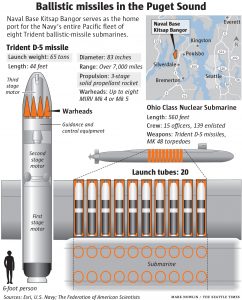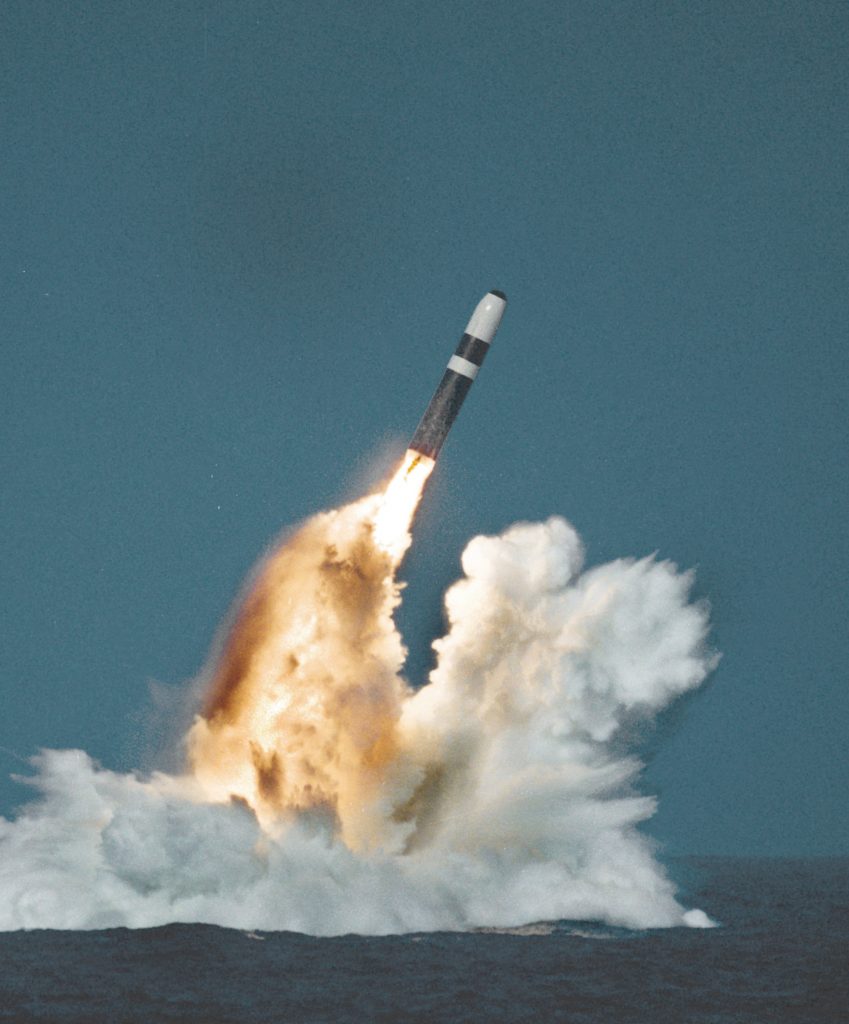The OHIO Class “Trident” ballistic missile submarine fleet provides the sea-based "leg" of the triad of U.S. strategic deterrent forces, and is considered to be the most survivable leg of the triad.
There are a total of fourteen Trident submarines; eight based at Naval Base Kitsap-Bangor in Silverdale, Washington; and six based at Naval Submarine Base Kings Bay in Kings Bay, Georgia.
The number of nuclear weapons deployed on the submarines based at Bangor make it the largest operational concentration of nuclear weapons in the US arsenal.
According to the US Navy: "Since the 1960s, strategic deterrence has been the SSBN's [Fleet Ballistic Missile Submarine] sole mission, providing the United States with its most survivable and enduring nuclear strike capability. The Navy's ballistic missile submarines, often referred to as "boomers," serve as an undetectable launch platform for intercontinental missiles. They are designed specifically for stealth and the precise delivery of nuclear warheads." 
Trident submarines are nuclear powered, and were manufactured by General Dynamics Electric Boat.
Each Trident submarine has 24 launch tubes capable of carrying 24 Trident II D5 ballistic missiles, manufactured by Lockheed-Martin. Each missile is capable of carrying up to eight thermonuclear-armed warheads. The two warheads designed for the Trident are the W76 (100 kiloton yield), and the W88 (475 kilotons). The D5 has a range of 4000 nautical miles.
First deployed in 1990, the D-5 is undergoing a life extension program to keep it operational through 2040.
Should the order come, missiles are launched using compressed air while the submarine is submerged, fly into space, steer in space using satellite navigation, then the warheads separate to maneuver onto different targets with a high degree of accuracy. Total flight time is 25 minutes or less, depending on how close the submarine is to the target.
In keeping with the New START Treaty, during a six-month period in 2017, 20 Trident launch tubes were deactivated, corresponding to four tubes on five Trident submarines. Two of those submarines were in dry dock for refueling and not part of the operational force.
In total, the United States has deactivated 56 Trident launch tubes since the New START treaty went into effect in 2011, although the first reduction didn’t begin until after September 2016 – more than five years into the treaty.
Of the 280 Trident launch tubes, only 212 were counted as deployed with as many Trident II missiles loaded. The treaty counts a missile as deployed if it is in a launch tube regardless of whether the submarine is deployed at sea. The United States has declared that it will not deploy more than 240 missiles at any time. Assuming each deployed submarine carries a full missile load, the 212 deployed missiles correspond to 10 submarines fully loaded with a total of 200 missiles. The remaining 12 deployed missiles were onboard one or two submarines loading or offloading missiles at the time the count was made.
The data shows that the 212 deployed missiles carried a total of 945 warheads, or an average of 4 to 5 warheads per missile, corresponding to 70 percent of the 1,344 deployed warheads as of September 1, 2017 (the New START count was 1,393 deployed warheads, but 49 bombers counted as 49 weapons don’t actually carry warheads, leaving 1,344 actual warheads deployed). If fully loaded, the 240 deployable SLBMs could carry nearly 2,000 warheads.
The Navy has been replacing the original Trident II D5 missile with an upgraded version known as Trident II D5LE (LE for life-extension). The upgraded version carries the new Mk6 guidance system and either the enhanced W76-1/Mk4A warhead or the high-yield W88-0/Mk5. In the near future, according to the Trump administration’s Nuclear Posture Review (NPR), some of the missiles would be equipped with a low-yield version of the W76-1.
The Navy is developing a new fleet of 12 Columbia-class missile submarines to begin replacing the Ohio-class SSBNs in the late-2020s. The Trump NPR states that “at least” 12 will be built. Each Columbia-class SSBN, the first of which will deploy on deterrent patrol in 2031, will have 16 missile tubes for a total of 192, a reduction of one-third from the current number of SSBN tubes. Ten deployable boats will be able to carry 160 Trident II D5LE missiles with a maximum capacity of 1,280 warheads; normally they will likely carry about the same number of warheads as the current force, with an average of about 5 to 6 warheads per missile.
General Dynamics’ Electric Boat and Huntington Ingalls’ Newport News Shipbuilding will build the New Trident submarines – one in 2021, one in 2024, and then one a year in 2026 through 2035.
(Updated February 12, 2018)





